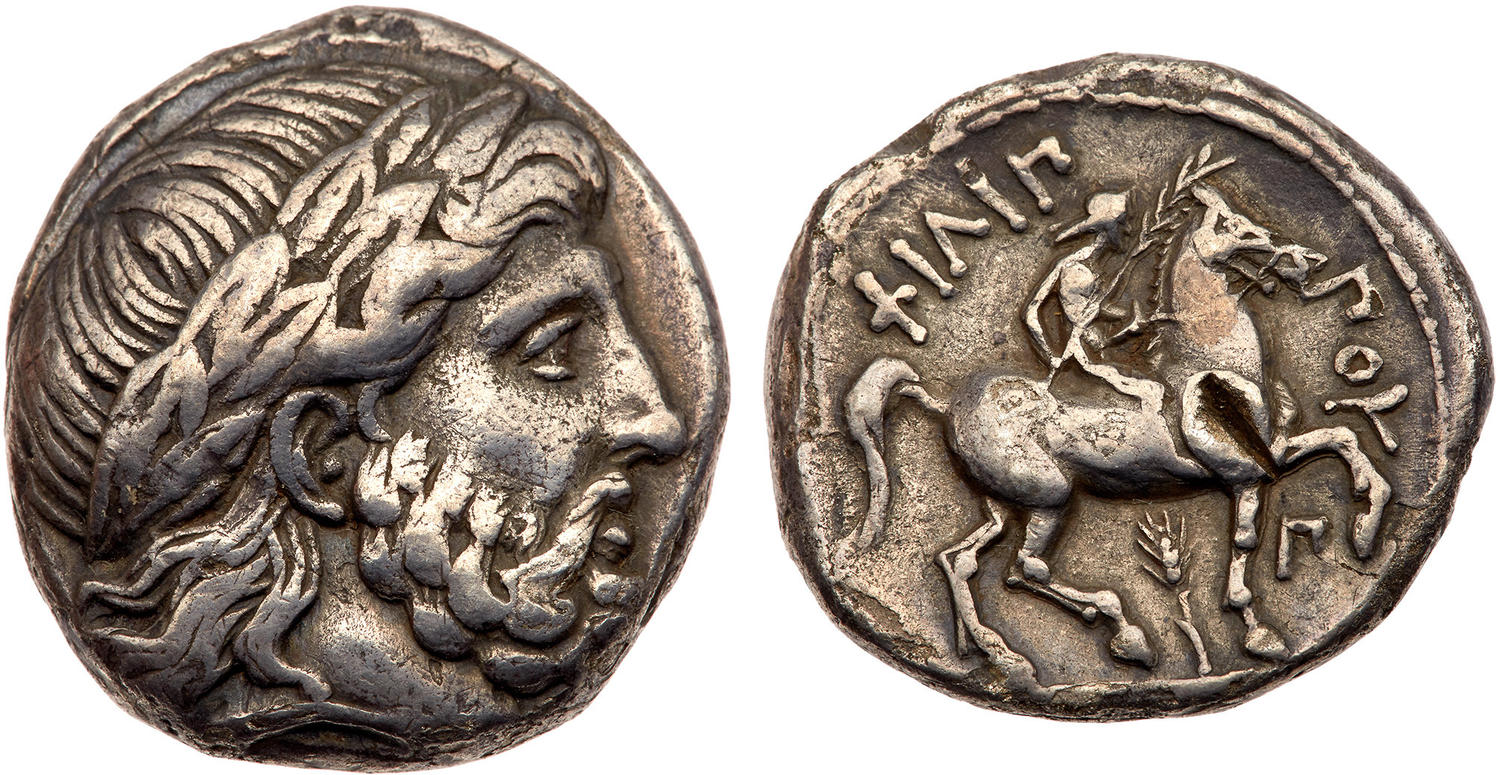H 114 - Amphipolis (Philip II), silver, tetradrachms (357-348 BCE)
From SILVER
359 BCE - 348 BCE Silver 23,216 kg
Description
| ObverseInscription or printing placed on the obverse.: | Head of Zeus right, wearing laurel wreath. Border of dots. |
| ReverseInscription or printing placed on the reverse.: | ΦΙΛΙΠΠΟΥ (Greek).Youth on horseback right, holding palm, beneath horse's belly, grain ear, below raised foreleg, Π. |
Mint and issuing power
| MintIdentifies the place of manufacture or issue of a numismatic object.: | Amphipolis | Ancient regionAncient region.: | Macedon | Modern countryModern country: Greece | AuthorityIdentifies the issuing power. The authority can be "pretended" when the name or the portrait of X is on the coin but he/she was not the issuing power. It can also be "uncertain" when there is no mention of X on the coin but he/she was the issuing power according to the historical sources: | Philip II (Argead king, 359-336 BC), Macedonian kingdom |
Chronology
| FromIdentifies the initial date in a range assigned in a numismatic context. | 359 BCE | toIdentifies the final date in a range assigned in a numismatic context.. | 348 BCE | PeriodTime period of the numismatic object.: Classical 480-323 BC |
Physical description
| MetalThe physical material (usually metal) from which an object is made.: | Silver |
Median weightMedian of the weights of numismatic objects (in grams). in grams | 14.40 | DenominationTerm indicating the value of a numismatic object. Examples: tetradrachm, chalkous, denarius.: | tetradrachm |
StandardStandard.: |
Image

H114 Zeus Amphipolis.jpeg [1]
References
| Die study referencePublication of the study: | Le Rider 19771Le Rider 1977 | ||
| Coin series referenceReference to coin series study: | Sear II2Sear II, n° 6677-6684, RQEMH3RQEMH, n° 114 | ||
Obverse dies distribution
| FrequencyFrequency of specimen in distribution. ᵖ | Number of obversesNumber of obverse dies. ᵖ (o) | % (o) | Number of coinsNumber of coins. (n) | % (n) | Die nameName(s) of the die(s). |
| 1 | 22 | 31.88 | 22 | 8.06 | 5, 6, 7, 9, 11, 12, 25, 26, 28, 44, 47, 48, 49, 52, 53, 58, 63, 65, 72, 73, 78, 82 |
| 2 | 9 | 13.04 | 18 | 6.59 | 19, 20, 37, 38, 42, 57, 60, 61, 79 |
| 3 | 8 | 11.59 | 24 | 8.79 | 2, 4, 8, 10, 21, 27, 40, 46 |
| 4 | 6 | 8.7 | 24 | 8.79 | 24, 32, 35, 55, 56, 77 |
| 5 | 7 | 10.14 | 35 | 12.82 | 3, 36, 41, 59, 66, 74, 75 |
| 6 | 4 | 5.8 | 24 | 8.79 | 1, 29, 30, 39 |
| 7 | 2 | 2.9 | 14 | 5.13 | 18, 76 |
| 8 | 4 | 5.8 | 32 | 11.72 | 23, 43, 64, 67 |
| 9 | 4 | 5.8 | 36 | 13.19 | 17, 22, 34, 45 |
| 11 | 1 | 1.45 | 11 | 4.03 | 31 |
| 12 | 1 | 1.45 | 12 | 4.4 | 62 |
| 21 | 1 | 1.45 | 21 | 7.69 | 71 |
| Total | 69 of 69 | 100 | 273 of 273 | 100 |
Reverse dies distribution
no distribution is available
Quantification
| Number of obversesNumber of obverse dies. ᵖ (o) | 69 | Number of singletons (o1)The number of singleton coins. ᵖ | 22 |
| Number of reverse diesNumber of reverse dies. (r) | 135 | Number of coinsNumber of coins. (n) | 273 |
| Coins per obverse dieNumber of coins per obverse die. (n/o) | 3.96 | Coins per reverse dieNumber of coins per reverse die. (n/r) | 2.02 |
| Reverse per obverse ratioRatio of obverse dies divided by reverse dies. (r/o) | 1.96 | Percentage of singletons (o1)number of coins (n) divided by the number of singletons (o1) ᵖ | 31.88 % |
| Original number of dies (O) (Carter 1983 formula)The estimation of the number of coins according to Carter 1983 ᵖ | 80.61 | Coins struck if 20,000 as average productivity per dieCoins made if the average productivity for obverses (according to Carter) is 20,000. ᵖ | 1,612,200 |
| Original number of dies (O) (Esty 2011 formula)The estimation of the number of coins according to the singleton formula in Esty 2011 ᵖ (O) | 92.34 | Survival rate if 20,000 as average productivity per dieSurvival rate if average productivity is 20,000. ᵖ | 0.00017 |
| Coverage (o = % of O) (Esty 1984 formula)Esty 1984 - coverage (% of O) ᵖ (o = % of O) | 91.94% | Die productivity if survival rate 1/2,000Average productivity if survival rate is 1/2,000. ᵖ | 6,773.35 |
| Weight of silver (in kg) if 20,000 coins per die (O = Carter formula)Carter 1983 * Median weight * 20000 (*10 if gold or electrum) ᵖ | 23,216 kg <br /> 23,216 kg | Die productivity if survival rate 1/5,000Average productivity if survival rate is 1/5,000. ᵖ | 16,933.38 |
Remarks
Most likely one single workstation
References
- ^ Le Rider, Georges (1977), Le Monnayage d'argent et d'or de Philippe II frappé en Macédoine de 359 à 294, Paris, Bourgey.
- ^ Sear, David R. (1979), Greek coins and their values. Vol. II, Asia and North Africa, London, xlviii, p. 317-762
- ^ Callataÿ, François de (1997), Recueil quantitatif des émissions monétaires hellénistiques, Numismatique Romaine, Wetteren, X + 341 p.